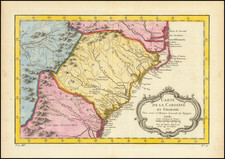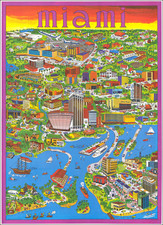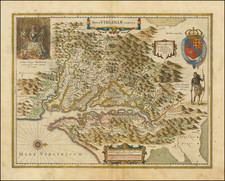French Discoveries along the Coast of Georgia in 1562
De Bry's map is based upon an original drawing by Jacques Le Moyne. The text describes discovery by the French of six rivers, which the French named the Loire, Charente, Garonne, Gironde, Belle, and the Grande. The first of these, the Loire, is not marked on the engraving but is thought to be Altamaha Sound. The others are marked respectively Charenta (Sapelo Sound), Garumna (St. Catherines Sound), Gironda (Ossabaw Sound) and Bellum (Wassaw Sound).
This work was published by Theodor de Bry from manuscript notes and drawings made by Jacques le Moyne de Morgues, an illustrator and explorer, who sailed with René de Laudonnière on the 1564 Huguenot expedition to Florida.
Overview of the Ribault and Laudonnière Expeditions in 1562 and 1564
A French expedition, organized by Protestant leader Admiral Gaspard de Coligny and led by the Norman navigator Jean Ribault, landed at the site on the River of May (now the St. Johns River) in February 1562. Ribault explored the mouth of the St. Johns River in Florida and erected a stone monument there before leading the party north and establishing a settlement on Parris Island, South Carolina. He then sailed back to France for supplies while Laudonnière took charge of the colony. Finding conditions unfavorable on Parris Island, Laudonnière moved back to Florida where they founded Fort Caroline on the St. Johns Bluff, in what is now Jacksonville.
Ribault then returned to Europe to arrange supplies for the new colony, but was arrested in England due to complications arising from the French Wars of Religion, which prevented his return.
Without supplies or leadership, and beset by hostility from the native populations, all but one of the colonists sailed back to Europe after only a year. During their voyage in an open boat, they were reduced to cannibalism before the survivors were rescued in English waters. Meanwhile, René Goulaine de Laudonnière, who had been Ribault's second-in-command on the 1562 expedition, led a contingent of around 200 new settlers back to Florida, where they founded Fort Caroline (or Fort de la Caroline) atop St. Johns Bluff, on June 22, 1564. The fort was named for the reigning French king, Charles IX. For just over a year, this colony was beset by hunger, Indian attacks, and mutiny, and attracted the attention of Spanish authorities who considered it a challenge to their control over the area.
In June of 1565, Ribault had been released from English custody, and Coligny sent him back to Florida. In late August, Ribault arrived at Fort Caroline with a large fleet and hundreds of soldiers and settlers and took command of the settlement. However, the recently appointed Spanish Governor of Florida, Don Pedro Menéndez de Avilés, had simultaneously been dispatched from Spain with orders to remove the French outpost, and arrived within days of Ribault's landing. After a brief skirmish between Ribault's ships and Menéndez's ships, the latter retreated 35 miles south, where they established the settlement of St. Augustine. Ribault pursued the Spanish with several of his ships and most of his troops, but he was surprised at sea by a violent storm lasting several days. In a bold stroke, Menéndez marched his forces overland, launching a surprise dawn attack on the Fort Caroline garrison which then numbered about 200 to 250 people. The only survivors were about 50 women and children who were taken prisoner and a few defenders, including Laudonnière, who managed to escape; the rest were executed.
As for Ribault's fleet, all of the ships either sank or ran aground south of St. Augustine during the storm, and many of the Frenchmen onboard were lost at sea. Ribault and his marooned sailors were located by Menéndez and his troops and summoned to surrender. Apparently believing that his men would be well treated, Ribault capitulated. Menéndez then executed Ribault and several hundred Frenchmen as Lutheran heretics at a place now known as Matanzas ("massacres") Inlet. This atrocity shocked Europeans even in that bloody era of religious strife. This place is known today by a fort built much later, Fort Matanzas. This massacre put an end to France's attempts at colonization of the southeast coast of North America.
Le Moyne's highly important account of this transatlantic voyage, known today from a Latin edition published in Frankfurt in 1591 by Theodore de Bry, indicates that it was the King who instructed the artist to accompany the expedition, headed by Jean Ribault and Rene Goulaine de Laudonniere, as official recording artist and cartographer. Although only one original drawing by Le Moyne of an American subject is known today, the depiction of ' Athore showing Laudonniere the Marker Column set up by Ribault,' executed in watercolor and gouache on vellum, now in the New York Public Library, the second volume of De Bry's great series of publications on voyages to the New World, contains forty-two engraved illustrations and maps alleged to have been made on the spot by Le Moyne. The text by de Bry describes and analyzes these images, and his book constitutes a major landmark in the literature of the early exploration of the Americas.
Jacquese Le Moyne.
Le Moyne was born about 1533 in Morgues, in the Loire Valley. The first thirty years of his life are undocumented, but it seems reasonable to suppose that he trained as an artist, which was at the time a notable center both for cartography and for illumination. Le Moyne probably worked at the court of King Charles IX of France, although there is no documentary record of his work before his departure for Florida in 1564.
Le Moyne accompanied the French expedition of Jean Ribault and René Laudonnière in an ill-fated attempt to colonize northern Florida. They arrived at the St. Johns River in 1564, and soon founded Fort Caroline near present-day Jacksonville. Painting in the Calvinist style, he is mostly known for his artistic depictions of the landscape, flora, fauna, and, most importantly, the inhabitants of the New World. His drawings (as primarily known through the engravings of De Bry, which were copied from Le Moyne's work), are largely regarded as some of the most accessible data about the cultures of the Southeastern Coastal United States; however, many of these depictions and maps are currently being questioned by historians and archaeologists as to their authenticity. During this expedition he became known as a cartographer and an illustrator as he painted landscapes and reliefs of the land they crossed.
Theodor de Bry (1528-1598) was a prominent Flemish engraver and publisher best known for his engravings of the New World. Born in Liege, de Bry hailed from the portion of Flanders then controlled by Spain. The de Brys were a family of jewelers and engravers, and young Theodor was trained in those artisanal trades.
As a Lutheran, however, his life and livelihood were threatened when the Spanish Inquisition cracked down on non-Catholics. De Bry was banished and his goods seized in 1570. He fled to Strasbourg, where he studied under the Huguenot engraver Etienne Delaune. He also traveled to Antwerp, London, and Frankfurt, where he settled with his family.
In 1590, de Bry began to publish his Les Grands Voyages, which would eventually stretch to thirty volumes released by de Bry and his two sons. The volumes contained not only important engraved images of the New World, the first many had seen of the geographic novelties, but also several important maps. He also published a collection focused on India Orientalis. Les Grands Voyages was published in German, Latin, French, and English, extending de Bry’s fame and his view of the New World.

![[ Georgia Coast ] Sex alia flumina a Gallis observata. IIII. By Theodor De Bry](https://storage.googleapis.com/raremaps/img/small/97965.jpg)









![[North Carolina]. Carte Geographique, Statistique Et Historique De La Caroline Du Nord](https://storage.googleapis.com/raremaps/img/small/57603.jpg)
![[ New England / Northeast / Canada ] Tierra Nueva](https://storage.googleapis.com/raremaps/img/small/86737.jpg)
![[Florida & Bahamas] Amer. Sep. No. 62. Florides et Iles Lucayes](https://storage.googleapis.com/raremaps/img/small/101496.jpg)

